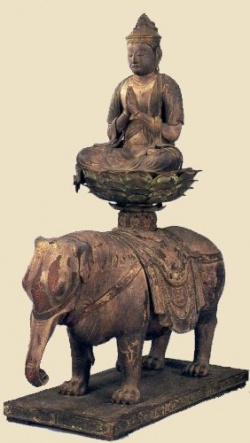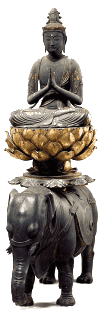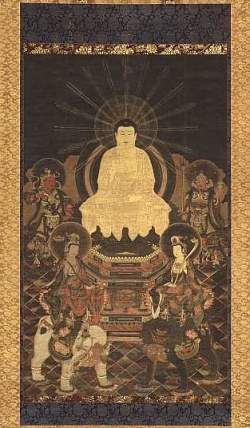Fugen Bosatsu (Bodhisattva)
Bodhisattva of Practice (Praxis)
Fugen Bodhisattva (Fugen Bosatsu 普賢菩薩) Fugen means "widely" (fu 普) "virtuous," "worthy," or "able" (ken 賢). S. Samantabhadra. A bodhisattva who is often paired with Monju Bodhisattva as one of two attendant figures who flank an image of Shakamuni Buddha. In this arrangement, Fugen is said to represent the Buddha's compassion (jihi 慈悲), whereas Monju represents the Buddha's wisdom (chie 智慧), those being the two complementary virtues that all bodhisattvas should cultivate. When paired with Monju, Fugen is the active party, practicing morality and meditation, fulfilling vows (gyōgan 行願) to save all living beings, and appearing in all buddha lands. Monju, in contrast, passively surveys the emptiness (kū 空) of all dharmas and cuts off all attachments to them. Fugen, riding a white elephant with six tusks, attends the Buddha on his right side. Monju, riding a lion, attends the Buddha on his left side.
In his left hand, Samantabhadra holds a lotus blossom. The lotus represents the basic underlying nature of mankind which is pure and undefiled. He sometimes rides on top of an elephant, one of the largest of animals. While it is gentle, the elephant has a strength that exceeds even that of a lion, and thus expresses the compassion of Samantabhadra.
Purpose and Vow
Samantabhadra Bodhisattva can be said to be the buddha of compassion, the counterpart to the wisdom of Mañjusri. As it also is in general Buddhism, Shingon Buddhism strongly emphasizes wisdom and compassion as the life force of the Buddha, and Samantabhadra is the Buddhist deity that manifests a powerful mind of compassion. This mind of compassion is known as the Practices and Vows of Samantabhadra that encourage us to engage in the practices by which everyone can become a buddha and carry out that vow everywhere.
These Practices and Vows are given in the Ten Vows:
1. to respect all buddhas,
2. to praise the benevolence of the buddhas,
3. to refrain from doing evil,
4. to make widespread offerings,
5. to take delight in the virtues of the buddhas,
6. to seek the teachings of the buddhas,
7. to aspire to the eternal world of the buddhas,
8. to learn from the buddhas,
9. to give benefit to all living beings, and
10. to transfer merit to the buddhas world.
On sanmaya satôban (Jpn.)
Om sammaya sat tvam (Om samayas tvam) (Skt.)
Om I am (you are) an embodiment of the pledge
| English | Japanese | Chinese | Sanskrit / Pali | Korean | Tibetan |
|---|---|---|---|---|---|
| Bodhisattva of Practice; Universally Good & Worthy |
Fugen Bosatsu 普賢菩薩 Henkitsu 遍吉 |
Pǔxián Púsà, Puxian, Pu Hsien, P'u-hsien |
समन्तभद्र Samantabhadra Viśvabhadra |
[[Bohyeon<br]]/>[[Pohyŏn<br]]/>보현 | Kun tu zang po, Kuntu Zangpo |
- Origin India
- Bodhisattva of Universal Goodness, Virtue, & Worthiness
- Great Conduct Bosatsu; made 10 vows of practice & faith
- Symbolizes praxis (diligent practice of Buddhist tenets)
- One Who Is All-Pervadingly Good
- One Whose Beneficence is Everywhere
- Protector of Those Who Teach the Dharma (Buddhist Law)
- Embodies Wisdom of Essential Sameness
- Prominent in Lotus Sutra & Patron of Lotus-Sutra devotees
- Popular by Heian era among Japan's Tendai Sect
- Often depicted riding an elephant, with the deity's hands pressed together in prayer (the so-called praying-hands mudra, or Gasshō 合掌 Mudra, known in Sanskrit as the Añjali Mudra).
- One of 13 Deities 十三仏 (Jūsanbutsu) of Japan's Shingon Sect of Esoteric Buddhism (Mikkyō 密教). In this role, Fugen presides over the memorial service held on the 28th day following one's death and is associated with Gokan-ō 五官王 (the fourth judge of ten hell judges). In Shingon circles, this version of Fugen is represented with the the Sanmaya-in Mudra 三昧耶印 . In artwork, however, Fugen appears most commonly with the Gasshō (praying hands) mudra.
- Often appears with Monju Bosatsu flanking the Historical Buddha (Shaka) in Japanese artwork known as the Shaka Triad (Shaka Sanzon 釈迦三尊).
- Appears in both the Womb World and Diamond World mandalas. In the Taizōkai mandala, Fugen is positioned in the central Eight-Petal Court (Chūdaiihachiyō-in 中台八葉院) with left hand grasping a lotus surmounted with a sword, and also in the Monju Court (Monju-in 文殊院), with left hand holding a lotus topped with a three-pronged vajra.
- In the Kongōkai Mandala, Fugen is one of the 16 Deities of the Auspicious Aeon and also identified as the esoteric deity Kongōsatta 金剛薩た among the 16 Great Bodhisattva.
- The Tendai sect invokes a variant form, the Fugen Enmei Bodhisattva 普賢延命菩薩, in a special rite for longevity known as the Fugen Enmei Hō 普賢延命法. In this role, Fugen can appear in two different forms -- as a two-armed deity holding a five-pronged vajra in right hand and a bell in the left while sitting atop a lotus supported by three elephants (or by a single three-headed elephant); or as a 20-armed deity sitting atop a lotus sometime supported by four elephants. This latter form appears in the Henchi-in 遍知院 section of the Taizoukai mandala.
- ENNICHI (Holy Day). The 14th day of each month is considered Fugen's Ennichi 縁日, literally "related day" or "day of connection." This is translated as holy day, one with special significance to a particular Buddha or Bodhisattva. Saying prayers to the deity on this day is believed to bring greater merits and results than on regular days. Says the Digitial Dictionary of Buddhism (login = guest): "The deity is understood to be in special charge of mundane affairs on that day, e.g. the 5th is Miroku, 15th Amida, 25th Monju, 30th Shaka. According to popular belief, religious services held on such a day will have particular merit."
INTRODUCTION
Fugen is known as the "Great Conduct" Bodhisattva, for Fugen teaches that action and conduct (behavior) are equally important as thought and meditation. Fugen encourages people to diligently practice the Buddhist precepts of charity, moral conduct, patience, and devotion. Fugen made ten vows for practicing Buddhism, and is the protector of all those who teach the Dharma (Buddhist Law).
Fugen is often depicted on an elephant (traditionally a white elephant with six tusks). The six tusks represent overcoming attachment to the six senses, while the elephant symbolizes the power of Buddhism to overcome all obstacles. In artwork of Mahayana traditions, Fugen is often shown holding the wish-fulfilling jewel or a lotus bud, but in artwork of the esoteric sects, Fugen is commonly seated on a lotus petal rather than atop an elephant.
The lotus is a symbol of purity, and in Buddhist art, Shaka Buddha (the Historical Buddha) and other Buddhist deities are often pictured sitting or standing on a lotus or holding a lotus. Although a beautiful flower, the lotus grows out of the mud at the bottom of a pond. Buddhist deities are enlightened beings who "grew" out of the "mud" of the material world. Like the lotus, they are beautiful and pure even though they grew up in the material world. Fugen, moreover, is the patron of devotees of the Lotus Sutra, and the lotus is thus fittingly one of Fugen's main symbols.
BODHISATTVA OF PRACTICE
Fugen represents meditation and practice (praxis) in Mahayana Buddhism. Fugen is often accompanied by Monju Bosatsu, who in contrast symbolizes wisdom and the enlightened mind (realization). In Japanese artwork, Fugen and Monju are often shown flanking the Historical Buddha (Shaka) in a grouping called the Shaka Trinity (Shaka Sanzon 釈迦三尊), with Fugen placed to the right of the central Shaka statue and Monju situated on the left. In this triad, Fugen is often depicted holding a lotus flower and riding an elephant (to symbolize the great power of Buddhist practice in overcoming all obstacles). Monju is frequently depicted with a sword in one hand (to cut through ignorance), holding the Sutra of Wisdom in the other, and sitting atop a roaring lion (symbolizing the powerful voice of Buddhist Law).
In addition, in Asia, there is a grouping called the Four Great Bodhisattva, with each of the four symbolizing a specific aspect of Buddhism. They are Kannon (compassion), Monju (wisdom), Fugen (praxis), and Jizō (vast patience and salvation from suffering).
FUGEN AS PATRON OF WOMEN
Fugen probably arrived in Japan sometime in the 8th or 9th century, for Fugen was already a major deity during the last half of the Heian Period (794-1192 AD). Fugen is a central deity of the Garland Sutra (Avatamsaka Sutra; Jp. = Kegonkyō). Fugen also appears in the Lotus Sutra (Jp. = Hokekyō), which is one of the most important scriptures of Mahayana Buddhism throughout Asia, but especially popular and influential in Japan. According to one source:
- "In the Heian period, women of the Japanese court adopted a form of Buddhism based on the worship of the Lotus Sutra and Fugen Bodhisattva. The Lotus Sutra is the principle Buddhist text concerned with the salvation of women, and Fugen is the protector Bodhisattva of the disciples of the Lotus Sutra. Thus did the women of the time adopt Fugen as their protector."
Indeed, in the 12th chapter (Devadatta) of the Lotus Sutra, the daughter of the Dragon King Sagara attains enlightenment at the young age of eight, illustrating the universal possibility of Buddhahood for both men and women. In Japan, Fugen is also one of the Thirteen Deities, the one who presides over the memorial service held on the 28th day following one's death. There are other forms of Fugen in Japan as well. The esoteric sects have their own special representations of Fugen in their Womb World and Diamond World mandalas. For example, the Tendai sect invokes a variant form, the Fugen Enmei Bodhisattva 普賢延命菩薩, in a special rite for longevity known as the Fugen Enmei Hō 普賢延命法.
MORE ABOUT FUGEN BOSATSU

Quoted from JAANUS: Literally "universally good;" also called Henkitsu 遍吉. A bodhisattva who is shown mounted on a six-tusked white elephant and appears to devotees in order to protect and instruct them. In Mahayana Buddhism he plays a central role in the KEGONKYOU 華厳経 (Sk: Avatamsaka-sutra), the pilgrimage mandara of fifty-five saints preserved at Toudaiji 東大寺 in Nara. At the same time, according to the HOKEKYOU 法華経 or Lotus Sutra. (Sk: Saddharmapundarika-sutra) he is closely associated with Monju Bosatsu, the principal bodisattva who represents wisdom and enlightenment.
Together they serve as the two attendants of Shaka Nyorai (the Historical Buddha), in one version of the Shaka Triad (Shaka Sanzon), with Fugen on the right symbolizing praxis and Monju on the left symbolizing wisdom. In Japan, because of the great popularity of the Lotus Sutra, Fugen is most commonly represented riding an elephant as described in that text, usually with his hands clasped together but sometimes holding a lotus, scepter or scroll. Renowned examples of pictorial representations are kept at Tokyo National Museum (late Heian period mid 12c) and Bujouji 豊乗寺 (Tottori prefecture; late Heian period 12c), while a representative example of a statuary image dates from the Heian period (first half of 12c) and is held by the Okura Shuukokan 大倉集古館 (Tokyo).
In Esoteric Buddhism (Mikkyou 密教), Fugen is considered to symbolize the thought/mind of enlightenment, bodaishin 菩提心, and appears in both the Womb World and Diamond World Mandalas. In the Taizoukai mandala he appears in the central Eight-Petal Court, Chuudaiihachiyouin 中台八葉院 (holding a lotus surmounted with a sword in his left hand) and in the Monju Court, Monjuin 文殊院 next to Monju (holding a lotus surmounted with a three-pronged vajra in his left hand). In the Kongoukai Mandala he is included among the 16 Deities of the Auspicious Aeon (gengou juurokuson 賢劫十六尊) and is also identified with Kongousatta 金剛薩た among the 16 Great Bodhisattva (juuroku daibosatsu 十六大菩薩). In Japan he also figures among the so-called Thirteen (13) Buddha (juusanbutsu 十三仏), presiding over the memorial service held on the 28th day after a person's death.
A variant form of Fugen is called Fugen Enmei Bosatsu 普賢延命菩薩 and is invoked in the "Fugen Rite for Longevity" (Fugenenmei Hou 普賢延命法), regarded as an important rite especially in the Tendai 天台 sect. Fugen Enmei Bosatsu appears in two forms. The first is two-armed and seated on a lotus supported by either three elephants or a single three-headed elephant. He holds a five-pronged vajra in his right hand and a bell in his left hand. The second form is the 20-armed form (also appearing in the Henchiin 遍知院 of the Taizoukai mandala), seated on a lotus that is sometimes supported by four elephants. An example of a painting of the first form is that preserved at Matsunoodera 松尾寺 (Kyoto; mid 12c) and of the second that preserved at Jikouji 持光寺 (Hiroshima Prefecture 1153).
There are also examples of statuary images of both forms. Fugen also figures in the "Picture of Fugen and the Ten Demonesses" (Fugen juurasetsunyo-zu 普賢十羅刹女図), in which Fugen in his role as protector of devotees of the Lotus Sutra is depicted sitting on a six-tusked elephant and accompanied by ten demonesses (rasetsunyo 羅刹女; Sk: raksasi, who are also mentioned in the Lotus Sutra as tutelary spirits of the Lotus Sutra). These demonesses are depicted in either Tang Chinese costume (e.g., painting from the Heian period (12c) preserved at Rozanji 盧山寺, Kyoto or in Japanese dress (e.g., painting from Kamakura period (13c) in the Hinohara 日野原 Collection, Tokyo.
SWIFT IS HEAVEN'S VENGEANCE
Below Text Courtesy Kondo Takahiro. Monju Bosatsu and Fugen Bosatsu may remind us of the accidents at a nuclear power plant. Two fast breeder reactors located in Fukui Prefecture were named Monju and Fugen. However, Monju was temporarily shut down on December 8, 1995, due to a leak of sodium coolant. Ironically, December 8 was the day Sakyamuni (the Historical Buddha) attained enlightenment.
Also Fugen is supposed to be advanced thermal reactors using both uranium and plutonium as fuel. In 1995, however, the government gave up the plan to develop such reactors in the face of stiff opposition. The reactor, which entered service in March 1979, cost 68.5 billion yen to build, but may cost three times that amount to dismantle, or 200 billion yen (US$1.5 billion). From the Buddhist viewpoint, naming the reactors Fugen and Monju was blasphemy against the two Bodhisattva. Swift is heaven's vengeance.
ELEPHANT SYMBOLISM
In India, the Hindu god Ganesh (also Ganesha) is portrayed with the head of an elephant, and assists believers in overcoming all obstacles -- akin to the force of an elephant crashing through the jungle. The son of Parvati, Ganesh removes every difficulty and is invoked at the start of any new enterprise. The elephant may also symbolize unrestrained passion. Linked with Fugen Bodhisattva, the elephant symbolizes the overcoming of obstacles. In Japanese artwork, the Buddhist deity Taishakuten (Sanskrit = Indra) is often depicted riding an
elephant. This reflects Taishakuten's Hindu origin, for in India an elephant serves as the mount of Indra. In India, Indra often rides an elephant with 33 heads and 33 tusks named Erawan (Airavata). In Buddhist traditions, this symbolizes the 33 gods of the Trayastrimsha Heaven. Erawan, however, is often depicted as a three-headed elephant in artwork. The elephant is also closely associated with Shaka Buddha (the Historical Buddha). According to Buddhist mythology, when Shaka was 72 years old, his cousin and brother-in-law, the malevolent Devadatta, hoped to displace the
Buddha and take over leadership of the Sangha (Buddhist community). Devadatta released an elephant maddened with alcohol upon the Historical Buddha, but the elephant was struck by Shaka's spiritual power and fell prostrate before him. Some art historians claim this is the origin of the Semui-in Mudra (the "Fear Not" hand gesture) found commonly throughout Asia on statues of the Buddha. In other lore, Queen Maya, the mother of the Historical Buddha, dreamt of an elephant before giving birth to the Buddha. In his prior lives, it is said, the Buddha was once an elephant. Elephant symbolism is also linked to Fugen Bodhisattva (the page you are now viewing), who is commonly depicted riding an elephant as described in the Lotus Sutra.

